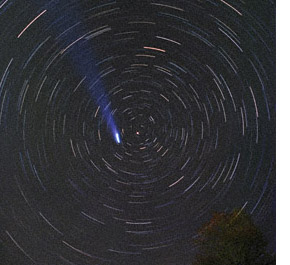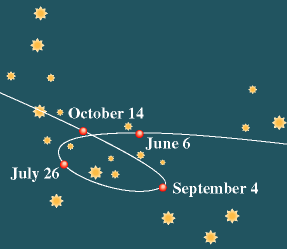The Origins of Astronomy
Astronomy has very old, prehistoric origins. Ancient peoples spent much more time under the night-time sky than we do (watching their flocks by night) and they did not have to contend with atmospheric pollution and bright city lights. Here is what they saw:
 1) The sky is full of stars, fixed in set patterns we call constellations. These have been mapped by generations of astronomers just as the Earth has been mapped by generations of cartographers. The Sun and the Moon slowly move against this background of constellations just as though the stars are fixed to a solid sphere and the Sun and Moon are gliding across it. Everything in the heavens rotates daily around a fixed point in the northern sky. The image at right is an illustration of this: it is a one-hour time-exposure photograph of the stars near the celestial North Pole, showing their arcs of rotation. The dot in the center is Polaris, the north star, which is almost on top of the North Pole and therefore does not rotate. (The blue streak is Comet Hyakutake, passing the Earth in 1996.)
1) The sky is full of stars, fixed in set patterns we call constellations. These have been mapped by generations of astronomers just as the Earth has been mapped by generations of cartographers. The Sun and the Moon slowly move against this background of constellations just as though the stars are fixed to a solid sphere and the Sun and Moon are gliding across it. Everything in the heavens rotates daily around a fixed point in the northern sky. The image at right is an illustration of this: it is a one-hour time-exposure photograph of the stars near the celestial North Pole, showing their arcs of rotation. The dot in the center is Polaris, the north star, which is almost on top of the North Pole and therefore does not rotate. (The blue streak is Comet Hyakutake, passing the Earth in 1996.)
2) If you watch the eastern horizon every morning at sunrise, you'll notice that the Sun does not rise at exactly the same place on the horizon each day. (Likewise for where it goes down at sunset.) Rather, it slowly shifts N-S along the horizon, moving to its southern-most position on Dec 21 (the shortest day of the year, or Winter Solstice) and to its northern-most position on Jun 21 (the longest day of the year, or Summer Solstice). The different rising points are what create the different lengths of the day throughout the year.
In other words, the Sun has two motions, unlike the stars. In addition to rotating across the sky every day, the Sun also moves against the starry background. The early Greeks considered the stars to be fixed to a crystalline sphere which simply rotated around the Earth. So, they figured the Sun must be on a second sphere attached to the inside of the starry sphere, rotating once per year around a second axis which was itself set at an angle to the rotation axis of the starry sphere. Such an arrangement could make the Sun rise and set daily, plus rotate yearly around the inside of the starry sphere, plus move N-S along the horizon, in the just manner observed.
 |
Photo montage of the yearly movement of the sunrise over an Illinois farm. Going from left to right, the photos were taken on the Summer Solstice, the Autumnal Equinox, and the Winter Solstice. They were taken from the same point facing east, which means that north is to the left. Note that the Sun does not rise directly upwards, but instead rises at an angle that does not change throughout the year. This is due to the tilt of the Earth. The size of the rising angle varies depending on your latitude. |
3) The Moon moves like the Sun, except differently. For one thing, it moves against the starry background far more swiftly. The place on the horizon where the Moon rises each day shifts N-S, like the Sun, but the Moon completes a full cycle in only 29.5 days, rather than a year. Also, the Moon does not follow exactly the same track every cycle, as the Sun does. After one year the Sun always returns to exactly the same spot against the starry background, but after 29.5 days, the Moon does not. It very slowly, over a span of about 19 years, weaves back and forth across an area which appears to circle the heavens like a belt. This belt is also known as the zodiac.
Most ancient peoples studied the heavens carefully, because it was felt that the heavenly objects could affect the Earth. If nothing else, they certainly created the seasons and made the tides. However, ancient civilizations either made no effort to explain what they saw, or they ascribed it to supernatural causes.
With one great exception. Roughly around 500 B.C., a civilization developed in ancient Greece which looked at the world much differently. The Greeks were fascinated by mathematics and by numbers, and they wanted to explain the motions of the heavenly objects in terms of geometry. The Greeks concluded that all the heavenly objects were attached to giant crystalline spheres which rotated around the Earth in perfect, uniform motion. This was partly because uniform rotation (at first glance) seems to describe the heavenly motions pretty well, and partly because the concept that the Heavens were composed of perfect spheres just seemed right to them. What else could the Heavens be built of except the most perfectly symmetric shape?
NOTE -- It is important to realize that theories in science are not "right" or "wrong" so much as they are useful or not useful. Visualizing the heavens as a giant sphere which surrounds the Earth is an idea that has its uses even today, and in any case, the real importance of the Greek ideas is not whether they were "right" or "wrong", but rather, the fact that the Greeks had physical ideas in the first place. The most important idea of physics is that there is such a thing as physics.
Perhaps the most critical difference between scientific and nonscientific concepts is that the scientific ones have consequences. If you decide that the Moon is being pushed around the sky by gods, then nothing the Moon does can surprise you because you have already made up your mind that it is all unfathomable anyway. Or, to use a more modern analogy, if you have already decided that an unexplained light in the sky was caused by UFOs from the planet Zargon, then nothing you say has to make any sense, because you can just claim that it was caused by unknown super-science. On the other hand, if you have a specific, physics-based model for how the Moon moves, then you are in a position to notice deviations from that model, and to ponder on what it means.
The crystalline-sphere model is a scientific model, because it has consequences. For example, if the Sun is moving uniformly, then it should be the case that the times between the summer solstice, the autumnal equinox, the winter solstice, and the vernal equinox are all equal. (That is, all four seasons should be exactly the same length.) Unlike nonscientific concepts, this prediction is something that can be tested and must be found true if we are to believe in the crystalline-sphere model.
When the Greeks looked closely at the solstice and equinox times, they were dismayed to find that the times are very close to equal -- but no cigar. They vary slightly, by about a day.
The Greek astronomer and mathematician Eudoxus was able to account for this problem by incorporating yet more spheres into the model (a total of three for the Sun, and five for the Moon) -- which nicely illustrates a good point about how scientific theories evolve. If you see something which doesn't quite work within your current theory, then the most natural thing is to extend or elaborate the theory, rather than throwing it out altogether.
 |
|
|
To account for the planetary movements, a variation of the principle of uniform circular motion was introduced. It was supposed that the planets moved along epicycles, which were smaller circles attached to and centered on larger circles (rather like orbital gears, if you know what those are). In principle, by superimposing circles rotating in opposite directions, one could create motions wherein the planets would move backwards at certain times.
Alas, Greek and then Roman astronomers discovered that one epicycle per planet could not adequately describe their motions, and so -- you guessed it -- they began piling epicycle upon epicycle, and eventually they were using hundreds to describe the motion of only five planets. Even worse, they eventually began using epicycles whose centers were off-set from the main circle, or which rotated around axes that did not go through the center of the circle. In short, they had moved a long, long way from the elegant crystalline spheres of Eudoxus, and no one actually believed that the epicycles meant anything physically. In fact, one couldn't possibly take epicycles literally, because most of the circles from the various planets overlay each other, and how could that be if they were solid? Also, many of the epicycles had grown so large that if a planet really was attached to one, it would have to swing dramatically inward and outward - that is, the planet's size and brightness would have to vary drastically as seen from the Earth. But this is not true.
By 200 A.D., when the Roman astronomer Ptolemy wrote the final, definitive treatise on epicycle theory (known as the Almagest, which is Arabic for "the greatest") epicycles were considered to be only mathematical fiction. The western half of the Roman empire collapsed during the fourth century, and when the great library at Alexandria was burned in 404 A.D., the first age of astronomy came to an end. Ptolemy's book was the last word on astronomy for nearly 1300 years.
 Ideas of Physics Homepage |
Secret of the Planets
Ideas of Physics Homepage |
Secret of the Planets 
For an Italian translation of this page, see Ahsan Soomro's page at
CouponToaster
For an Estonian translation of this page, see Martin Aus's page at Astronoomia
For an Urdu translation of this page, see Samuel Badree's page at
Mobile Mall